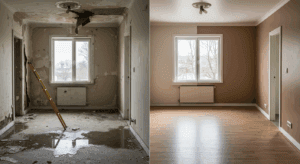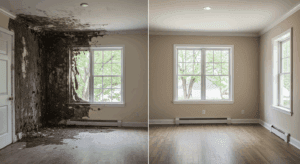Black mold is a common household issue that poses serious health risks and can cause significant damage to your property if left untreated. This comprehensive guide will walk you through everything you need to know about black mold, from identifying and removing it to preventing its return. By following these steps, you can protect your home and loved ones from the harmful effects of black mold.
Understanding Black Mold: What You Need to Know
Health Risks Associated with Black Mold
Black mold, scientifically known as Stachybotrys chartarum, releases spores that can cause various health problems. Prolonged exposure to these spores may lead to respiratory issues, allergic reactions, and even chronic illnesses. Symptoms include coughing, sneezing, skin irritation, and headaches. People with asthma or weakened immune systems are particularly vulnerable. Addressing black mold promptly is essential to safeguard your health.
Common Signs of Black Mold Infestation
Detecting black mold early can save you time and money. Look for visible signs such as dark green or black patches on walls, ceilings, or floors. A musty odor is another indicator of mold growth. Additionally, areas prone to moisture, like bathrooms, basements, and kitchens, are hotspots for mold infestation. If you notice peeling paint or water stains, inspect the area closely for mold.
Step-by-Step Black Mold Removal Process
Identifying and Fixing Moisture Sources
Mold thrives in damp environments, so the first step in addressing black mold is to identify and eliminate moisture sources. Check for leaky pipes, roof leaks, or poor drainage around your home. Use a dehumidifier to maintain indoor humidity levels below 50%. Fixing these issues will prevent mold from returning after removal.
Safety Precautions for Mold Removal
Removing black mold requires proper safety measures to protect yourself. Wear protective gear, including gloves, goggles, and a mask, to avoid direct contact with mold spores. Seal off the affected area to prevent spores from spreading to other parts of your home. Ensure proper ventilation during the cleaning process.
Effective Cleaning Solutions for Black Mold
To remove black mold, use a mixture of water and detergent or a commercial mold remover. Apply the solution to the affected area and scrub thoroughly with a brush. For porous materials like drywall or carpet, replacement may be necessary as mold can penetrate deeply. Dispose of contaminated materials in sealed bags to prevent further contamination.

For more detailed steps, check out our Ultimate Guide to Black Mold Removal.
Preventing Black Mold Growth in Your Home
Maintaining Low Humidity Levels
Controlling indoor humidity is key to preventing black mold. Use a dehumidifier in damp areas like basements and bathrooms. Monitor humidity levels with a hygrometer and keep them below 50%. Regularly check for condensation on windows and pipes, as this can indicate high humidity.
Improving Ventilation and Airflow
Proper ventilation helps reduce moisture buildup in your home. Open windows and use exhaust fans in bathrooms and kitchens to improve airflow. Ensure that your HVAC system is functioning correctly and clean the filters regularly. Good ventilation not only prevents mold but also improves indoor air quality.
Using Mold-Resistant Materials
When renovating or building, opt for mold-resistant materials such as drywall, paint, and insulation. These materials are designed to inhibit mold growth, making them an excellent long-term investment. Additionally, waterproofing your basement and sealing cracks in walls and floors can further protect your home from moisture and mold.
When to Call Professionals for Black Mold Issues
Signs You Need Expert Help
While small mold infestations can often be handled with DIY methods, there are situations where professional help is necessary. If the affected area exceeds 10 square feet, or if mold has penetrated deeply into walls or ceilings, it’s best to call in experts. Persistent health issues among household members may also indicate a severe mold problem that requires professional remediation.
What to Expect from Professional Mold Remediation
Professional mold remediation services involve a thorough inspection, mold testing, and removal. Experts use advanced equipment and techniques to ensure complete mold eradication and prevent future growth. They also address underlying moisture issues to provide a long-term solution. Learn more about professional services in our Comprehensive Guide to Mold Testing.
Black mold is a serious issue that requires immediate attention. By understanding its risks, following proper removal steps, and implementing prevention strategies, you can keep your home safe and mold-free. If the problem persists, don’t hesitate to seek professional help to ensure a thorough and effective solution. Protect your health and property by taking action today!




